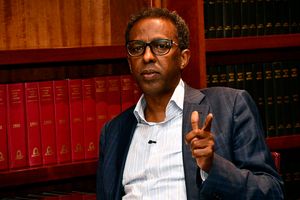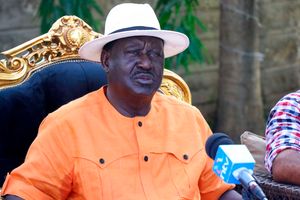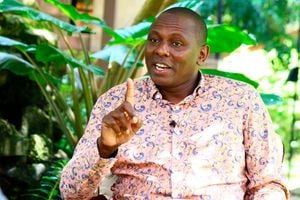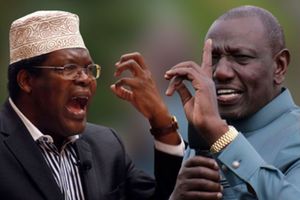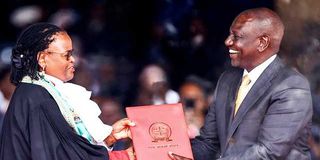
President William Ruto receives certificate from Chief Justice Martha Koome after taking oath of office on September 13, 2022.
After Ferdinand II and his wife Isabella I united Aragon and Castile into the Spanish Kingdom in 1478, the monarchs formed an organisation – the Spanish Inquisition – to fight heresy, a growing threat to Catholicism then.
But the inquisition veered off the road paved for it and became a dreaded hit squad operating above the law. It succeeded in keeping the monarch in control of the Spanish kingdom.
In Kenya, the judicial reforms have been an inquisition in the Executive’s attempts to exercise control over courts, top legal minds argue.
President William Ruto’s tirade against judicial officers is no different, experts say, even as they maintain that the Constitution has enough safeguards to protect the Judiciary from Executive excesses.
Law Society of Kenya (LSK) President, Eric Theuri, says the Executive is acting holier-than-thou, and that Dr Ruto should have used appropriate channels specifically presenting evidence of corrupt judges before the Judicial Service Commission (JSC).
“Corruption is rampant in the Judiciary just as it is in the other arms of government. The Executive cannot arrogate itself the duty to deal with corruption in the Judiciary,” Mr Theuri says.
“Why are the claims coming shortly after the government losing cases in court? Why not present the evidence through appropriate institutions instead of making unspecified allegations of corruption?”

Law Society of Kenya CEO Florence Muturi (left), President Eric Theuri (centre) and Vice President Faith Odhiambo (right) addressing the media at LKS Head office in Nairobi on December 18, 2023.
Former LSK president, Isaac Okero, says the statements and protests against Dr Ruto’s remarks are evidence that the Constitution is working to protect the Judiciary.
“People are genuinely alarmed that someone who promised to uphold the Constitution and even swore in judges after taking office is now calling the Judiciary corrupt when rulings don’t favour him. There was much hope when President Ruto swore in judges rejected by his predecessor. Could we be seeing his true colours,” Mr Okero asks.
Mr Paul Mwangi, an advocate and author of The Black Bar: Corruption and Political Intrigues Within Kenya’s Legal Fraternity, says President Ruto’s remarks could be an attempt to control the Judiciary, citing similar moves by past leaders.
During the Jomo Kenyatta presidency, Kenya was in a financial bind and could not sustain enough judges to settle disputes. There was also a short supply of qualified indigenous Kenyans to hold the positions.
The British government’s Overseas Development Administration helped plug the deficit by sourcing for expatriate judges on contract, and catered for their services. Their contracts, however, were in the hands of the Executive, through the Attorney-General – a presidential appointee.
Jomo Kenyatta’s administration got a hold of the Judiciary by dangling contract renewals to judges. Those who toed the line got renewals.
The trend continued under Daniel arap Moi’s administration.
After the failed August 1, 1982 coup, Moi started guarding his presidency more ruthlessly as he sought retribution against those he believed plotted the overthrow. He also hoped to scare those with such ambitions.
Some judges refused to take the contract renewal bait, which retained a semblance of judicial independence and blocked the president from overreach.
Justice Derek Schofield resigned in 1987 after refusing to drop a habeas corpus application by the family of businessman Stephen Karanja, who had been killed by police.

President William Ruto addresses mourners during the burial of Michael Maigo, father of Nyandarua Senator John Methu, in Njabini on January 2, 2024. He accused some members of the judiciary of derailing his government's development projects.
Then-Chief Justice Cecil Miller had took the case file after Justice Schofield refused to skew the case on instruction from the president.
Justice Miller was loyal to President Moi, who had appointed him for purposes of being a fixer and aid the Executive in tough matters to navigate.
Mr Mwangi recalls how Justice Miller once sent someone into a judge’s chamber to pick a file whose case was to be heard.
He says during the Jomo Kenyatta era, the Executive used subtle strategies like term contract renewals to subdue the Judiciary.
President Moi, he says, implemented more aggressive strategies, including changing laws.
“The file had been placed before Justice Daniel Aganyanya by mistake. He was one of the uncompromising judges and it was a case the Executive had an interest in. Someone went to Justice Aganyanya’s chambers and walked out with the file. The case was assigned to a pro-government judge,” Mr Mwangi says.
“Moi also started using force, like doing away with judges’ security of tenure. He used gatekeepers such as Miller and other judges who would determine cases in his favour.”
Judges like Schofield were a threat to Moi’s quest to become an imperial president.
By this time, there were permanent and pensionable judges, appointed by the president after a recommendation by the JSC. The Chief Justice was also appointed by the President upon recommendation by the JSC.
Between 1986 and 1988, President Moi engineered a law change to do away with security of tenure enjoyed by permanent and pensionable judges.
The move was aimed at dismissing any judicial officer who went against the wishes of the Executive.
President Moi already had control over appointment of the CJ, judges and magistrates.
The Constitution gave him authority to appoint judicial officers upon recommendation by the JSC. But he was also in charge of constituting the commission, giving the Executive control over the Judiciary.
Courts were largely President Moi’s playground, as few judges dared cross his path.
Then came President Mwai Kibaki in early 2003. One of his campaign pledges was to reform the Judiciary.
In 2003, Kibaki named Court of Appeal judge Aaron Ringera to head a tribunal that would investigate corruption in the Judiciary.
Justice Ringera prepared a long list, which saw at least 100 judicial officers kicked out. Those listed were given an option to resign.
While the public celebrated the purge, it later emerged that there was a political angle to the move.
According to Mr Mwangi, President Kibaki saw a chance to kill two birds with one stone – convince the public that the Judiciary had been rid of corrupt officers, and get an opportunity to appoint loyalists to key positions.
The purge, he says, was a farce and backs his position with the fact that Kibaki’s administration failed to enact laws to protect the Judiciary from intimidation by other arms of government.
President Kibaki, Mr Mwangi adds, started by piling pressure on CJ Bernard Chunga to resign. Justice Chunga had been elevated from Director of Public Prosecutions (DPP) to CJ by President Moi in 1999.

Lydia Achode (left) swears in Chief Justice Evan Gicheru during the ceremony to promulgate the new constitution held on 27th August 2010 at Uhuru Park Nairobi. Photo/Joan Pereruan
Justice Chunga quit and was quickly replaced by Justice Evan Gicheru.
“Kibaki comes in and realises that Moi’s Judiciary could be problematic. The radical surgery forced several judges out while making space for friendly ones. Kibaki also borrowed the gatekeepers tactic from Moi to gain control over the Judiciary,” Mr Mwangi says.
Among those named as President Kibaki’s gatekeepers was Justice Joseph Nyamu, who served as duty judge in the constitutional review division of the High Court.
While he consistently denied the claim, Justice Nyamu was eventually declared unfit to hold office during the 2012 vetting of judicial officers.
Justice Ringera, who was interviewed for CJ in 2016, said he would have handled the investigation differently.
He said those forced out were never given a chance to defend themselves.
Ironically, among the interviewees in 2016 was Justice Roselyn Nambuye.
Justice Nambuye was among judges that the Ringera-led commission wanted kicked out.
She challenged the tribunal findings and was reinstated.
She scored higher marks than Justice Ringera in the 2016 CJ interviews.
After the promulgation of the 2010 Constitution, four judges – Joseph Nyamu, Riaga Omollo, Emmanuel O’Kubasu and Samuel Bosire – were declared unfit to hold office.
The 2010 Constitution defanged the president by vesting power to hire and dismiss judges in the JSC.
The Constitution also limited Executive interference in putting together the commission.
Barely a year after Mr Uhuru Kenyatta and Dr William Ruto were sworn into office, the Executive found itself at crossroads with the Judiciary.
On November 29, 2013 President Kenyatta suspended six JSC members – Mohammed Warsame, Ahmednasir Abdullahi, Emily Ominde, Tom Ojienda, Christine Mango and Florence Mwangangi – following a petition from the National Assembly.
The petition and President Kenyatta’s suspension of the commissioners triggered a war involving the three arms of government.
The High Court ruled that the National Assembly has no control over the JSC.
In January, 2014, the JSC forwarded 25 names to President Kenyatta for appointment as judges.
The president only placed 14 names in the Kenya Gazette, leaving the others out.
Under the law, the president has no power to amend the JSC list.
This led to a standoff, which then-Chief Justice Willy Mutunga silently unlocked following protracted talks with the president.
The 11 judges were eventually appointed.
But from the 2014/15 financial year all through to President Kenyatta’s exit in September 2022, the budget of the Judiciary was affected as it more often than not shrank.
After Mr David Maraga replaced Dr Mutunga as Chief Justice, tensions between the Executive and Judiciary became more prominent.
Unlike his predecessor, Justice Maraga was not one to shy away from making public the fights between the arms of government.
Between 2019 and 2022, Justice Maraga publicly castigated President Kenyatta for failing to appoint 41 judges nominated by the JSC, and for the consistent budget cuts.
In June , 2020 the CJ called a press conference in which he said President Kenyatta had ignored several requests for meetings.
Then-Attorney-General Kihara Kariuki also called a press conference to fault Justice Maraga for “twisting facts and using public statements” to pile pressure on the President.


